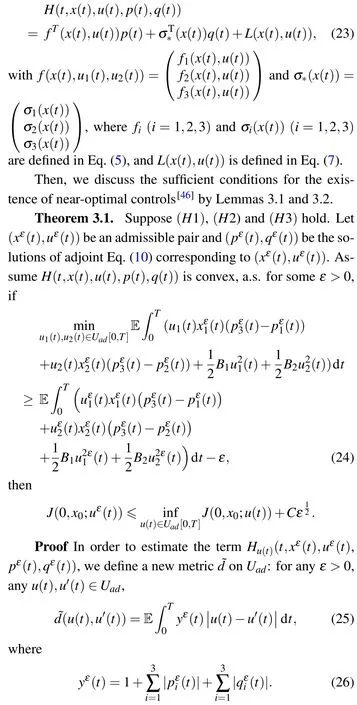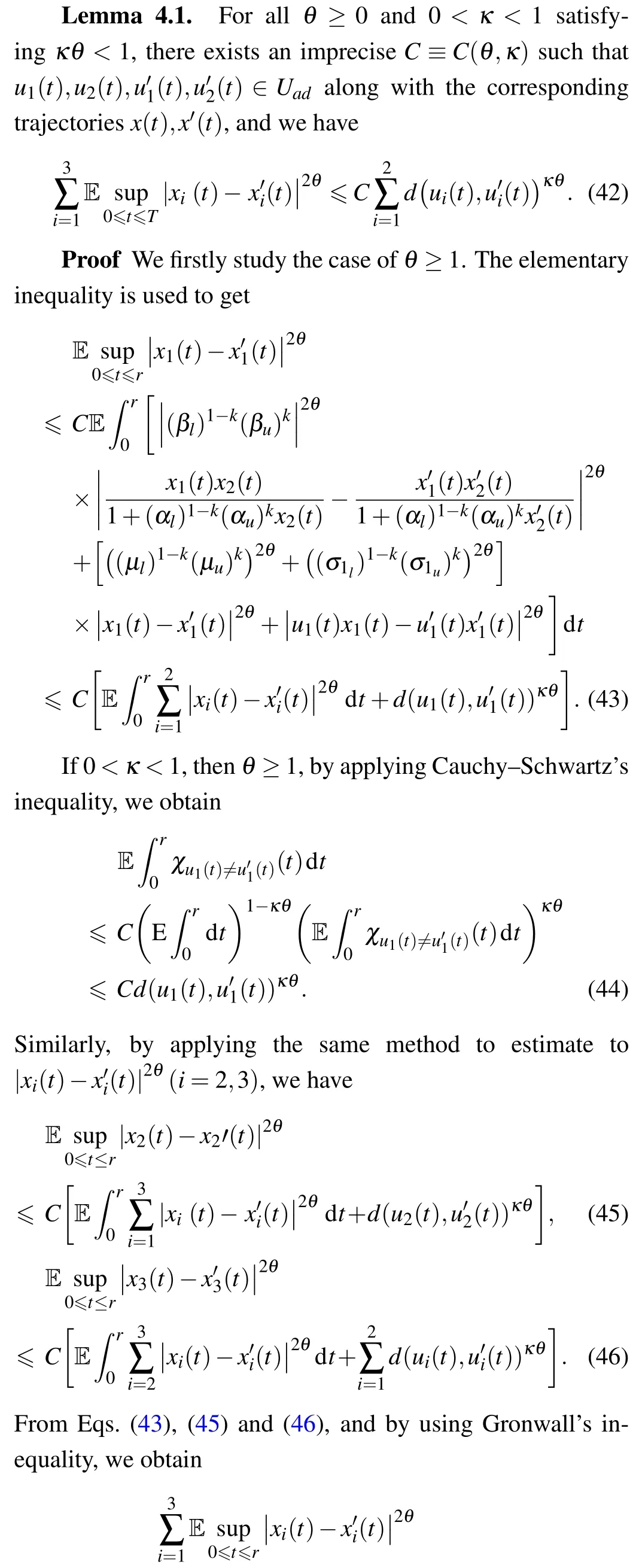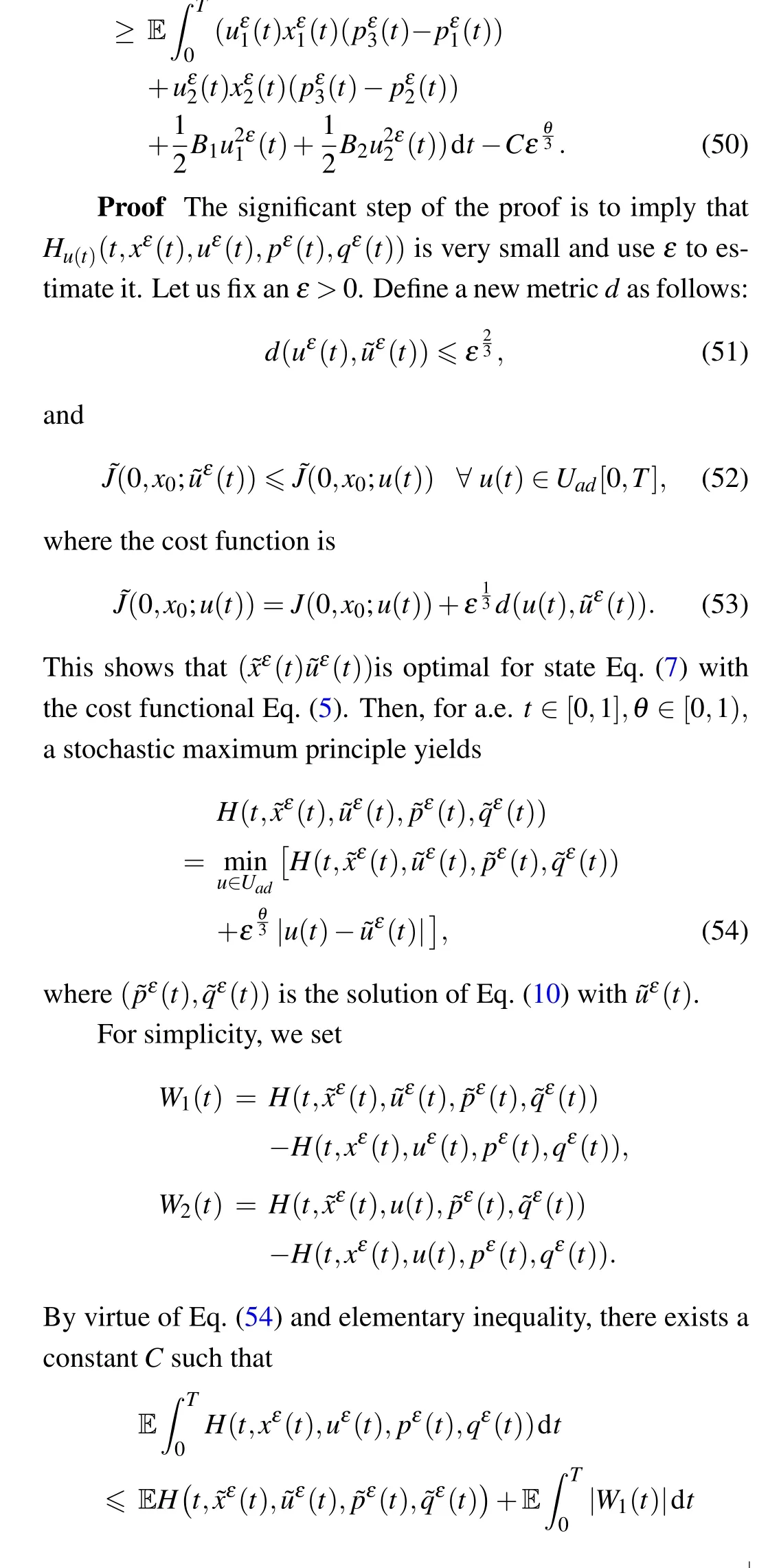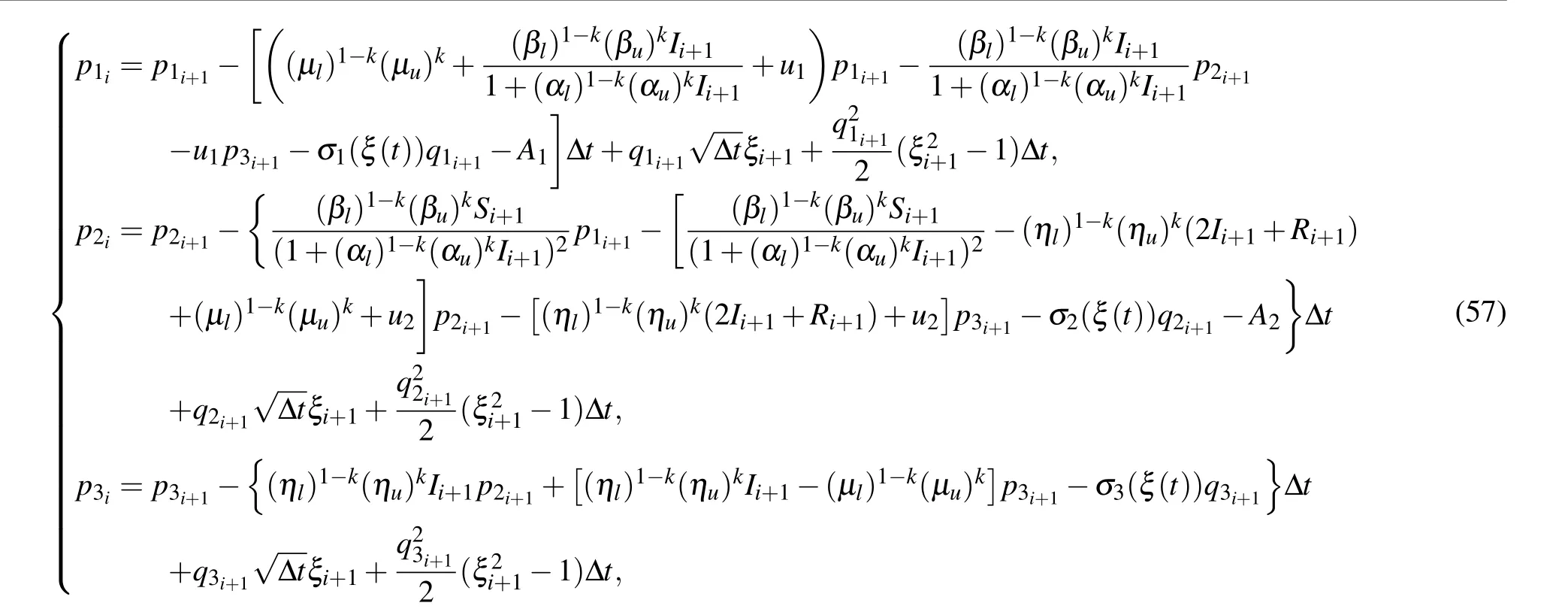Near-optimal control of a stochastic rumor spreading model with Holling II functional response function and imprecise parameters∗
2021-12-22LianganHuo霍良安andXiaominChen陈晓敏
Liang’an Huo(霍良安) and Xiaomin Chen(陈晓敏)
Business School,University of Shanghai for Science and Technology,Shanghai 200093,China
Keywords: rumor spreading,Holling II functional response function,near-optimal control,stochastic process
1. Introduction
Traditionally, a rumor is defined as a statement that has no basis in fact, and it is difficult for people to distinguish between true and false. In the past, rumors spread by word of mouth before getting official recognition, which had exerted a significant impact on human life. Nowadays, with the advent of the modern era of Internet, there are more and more channels for spreading rumors, such as Facebook, Titter,and WeChat,,which bring much wider and faster spreading. There is no doubt that the anonymous rumor spreaders and the diversity of rumor spreading channels make it more difficult to control the rumors effectively. To some extent,these rumors may bring individual anxiety, even may cause people to perform serious misleading behavior. Especially during the recent outbreak of COVID-19, different kinds of rumors spread willfully, posing a major threat to the social stabilization.[1–6]Therefore,there is no time to delay in studying the control strategies of rumor spreading model to restrain the rumor spreading and reduce its negative official effect.
The mechanism of rumor spreading, as may easily be imagined, has been studied by scholars, which can be traced back to the 1960s as far as possible. To start with, Daley and Kendal proposed a classical DK model to investigate the mechanism of rumor spreading, which laid the foundation for future research on rumor spreading.[7]Subsequently,the DK model was modified and improved to another novel MT model.[8]However,the previous models did not consider the topological characteristics of the social networks. After that, many scholars built the rumor spreading models based on different network structures to illuminate the process of rumor spreading in different environments.[9]For example,a rumor spreading model on small-world network found the threshold of rumor spreading.[10]In addition, they chose different views to modify rumor spreading models,such as SBD models,[11]SIQRS models,[12]and I2S2R models.[13]What is more,several scholars took some microscopic mechanisms into account to the process of rumor spreading, such as hesitating mechanism,[14]and forgetting mechanism.[15–18]Nevertheless,the above studies focused mainly on the final state of rumor spreading but ignored the dynamical process of rumor spreading. In terms of it, many scholars then made contributions to the dynamical properties of rumor spreading.[19–21]
It is well known that a rumor spreads through crowd contact.The previous studies have assumed that the probability of contact between two individuals is measured by either a constant or a linear function.However,the fact is complicated and changeable,and we also need to consider the individual’s psychology. For example, when the number of spreaders is very large,more ignorant individuals may choose to accept rumors and then turn into spreaders. In terms of it, a nonlinear function is better to measure the rate of rumor spreading and in accord with the actual situation.[22,23]In regard of this, Huo built a rumor spreading model considering the Holling-type II functional response function to describe the dynamical process for the rumor diffusion.[24]
Besides,there are various factors that influence the spread of rumors. In addition to internal factors such as individual psychology,the external environmental factors also exert large influence on the process of rumor spreading.[25–28]Especially in public emergencies, as events evolve constantly and external environment changes at random,people’s attitude towards rumors will change accordingly and the influence strength of rumor spreading will fluctuate randomly. Therefore, the deterministic model fails to describe a basic phenomenon of a rumor spreading system in the changing environment, which may cause random variations in the transmission. Clearly,it is more accurate for stochastic models to study rumor spreading process.
Combining these complexities above, we know that the influential factors of rumor spreading are complex and changeable, which indicates rumor spreading exerts a tremendously negative social influence and the lack of control will cause serious consequences. Therefore, effective measures must be taken to control the spread of rumors so as to reduce the negative impact on the society. Besides, optimization is an important technique to find the optimal control strategies. The optimal control theory is defined as establishing an objective function for optimizing the control effect and cost, and utilizing it to reduce the negative social influence brought by rumor spreading.At present,numerous deterministic models are studying the optimality in the field of rumor spreading.[29,30]However, it is very difficult to find the exact optimal control for stochastic models. Instead,we can obtain the near-optimal control. The near-optimal control exists with few restrictions and can be applied to more models.[31]For example,Guo studied the near-optimal control of a SIRS model that includes a nonmonotone incidence rate.[32]Meanwhile, various control strategies were involved in deterministic rumor spreading models, such as media awareness,[33]science education and official media coverage.[34]Here,we introduce the scientific knowledge and the refutation mechanism as two control strategies into a stochastic rumor spreading model and explore its near-optimal control. On one hand, scientific knowledge propagation is a necessary channel to strengthen individual’s comprehensive quality and broaden their knowledge. On the other hand, refutation mechanism can help rumor spreaders learn the truth of a specific rumor directly so that spreaders no longer spread the rumor. Thus, it makes sense that we consider both scientific knowledge propagation and refutation mechanism as control strategies in a rumor spreading model to control rumor spreading effectively.
A good mathematical model,with an elaborate set of assumptions,can surely deduce almost all of the phenomena of the rumor spreading. However, in the fact, most of the parameters related to rumor spreading system are not certain.Therefore, it is necessary to use uncertain parameters or interval valued parameters corresponding to models that reflect the real world problems. At present, many scholars used interval valued parameters to describe various problems.[35,36]However,it is rare to use an interval valued parameter to discuss a rumor spreading model. Hence,we use interval valued parameter in our model to explore different phenomena under different interval valued parameters.
The novelty of this work is to establish a novel rumor spreading model considering Holling II functional response function, stochastic disturbance and imprecise parameters simultaneously to be further accord with the practical situation,propose two control strategies to reduce rumor spreading,and explore some sufficient and necessary conditions for the nearoptimality of the novel model. The frame of the paper is illustrated as follows. In Section 2,we propose a stochastic rumor spreading model with Holling II functional response function and imprecise parameters. In Sections 3 and 4, we demonstrate the sufficient and necessary conditions of near-optimal control for the stochastic rumor spreading model,respectively.In Section 5,we carry out some numerical simulations to confirm our results. Finally,we come to some conclusions in Section 6.
2. Near-optimal control of a stochastic rumor spreading model
In a classical DK rumor spreading model,[7]the total populationN(t) is grouped into three categories:S(t),I(t), andR(t), whereS(t)represents ignorants who have not heard the rumor at timet,I(t) denotes spreaders who believe in and spread the rumor actively at timet, andR(t) represents stiflers who have removed from the spreaders and stop spreading at timet. Then,according to the classical DK model,rumors spread through contact betweenS(t),I(t) andR(t). Among them, what is worth mentioning is that the transfer fromI(t)toR(t) happens whenever an active spreaderI(t) encounters either another active spreaderI(t)or a stiflerR(t). Moreover,the transmission rate of rumors is more than related to the individual’s propagation ability, and it is under the influence of psychological factors, that is, whether an ignorant individual chooses to accept rumors and transfer to a spreader is restrained by the density of the spreaders. Hence, we believe a nonlinear transmission rate can better manifest the law of the spreading betweenS(t) andI(t), and the interactive process is consistent with Holling II functional response function. In regard of this, we introduce the Holling II functional response function[37–40]to the classical DK rumor spreading model. The model is given by


p: The immunization rate of the new members.
b: A constant input rate of new individuals into a given community.
µ: The natural immune rate.
η:The immunization rate transforming from the spreader into the stifler.
Nevertheless,besides internal personal psychological factors,external environment disturbance and evolution of events also influence the process of rumor spreading to some degree. Especially in emergencies, the stochastic disturbance even cannot be neglected. Take an example from COVID-19,on the evening of October 29,2020,an unconfirmed news that a Chinese overseas student died from a novel coronavirus caused a sensation throughout the study abroad circle in Italy.As soon as the unconfirmed news came out,people were worried and regretful about what had happened to the classmate,and then the rumor spread widely. After contacting a number of hospitals to confirm the information, no news of death of the student was received. At this time, people were full of doubts about the student,so people began to disbelieve the rumor and seldom spread it. Subsequently,the‘dead classmate’published a post in which he admitted fabricating the story to attract attention. People became scandalized and started strongly condemn for this brazen act, and the rumor was restrained to some extent. From above we can see, the spread of rumor and people’s attitude towards the rumor may vary accordingly with the changes of the stochastic disturbance.Hence,it is essential to consider stochastic disturbance in the research of rumor spreading, which may contribute to more precise results. Therefore, based on the deterministic model,we add stochastic disturbance to the initial model in that we can better grasp the dynamic properties of rumor spreading.An important concept in stochastic modelling is the Wiener process. The white noise is an extremely useful concept to model the rapidly fluctuating phenomena. Meanwhile, the main source of noise is that there are all kinds of uncertainties in a rumor spreading system such as evolution of events or external intervention. Hence, we add a Wiener process to model(1),which is a continuous time stochastic process,making the system more realistic and precise than the deterministic model. The stochastic rumor spreading model is given by

whereB1(t),B2(t) andB3(t) are all real-valued Brownian motion defined on the complete probability space(Ω,F,{Ft}t≥0,P)with a filtration{Ft}t≥0satisfying the usual conditions(i.e.,it is right continuous and increasing whileF0contains allP-null sets),andσi(i=1,2,3)are the strength of white noise.
There is no doubt that rumor spreading brings serious negative influence on individuals and society. Especially in a stochastic environment, the impact strength of rumor spreading is even greater,which indicates urgency to restrain the rumor spreading effectively and reduce its negative social influence as far as possible. Therefore, we consider some control strategies during the process of rumor spreading to reduce its negative influence. Take COVID-19 for example, there was a rumor that drinking can prevent novel coronavirus, which is mainly to drill the knowledge of insufficient national science knowledge. The attitude of individuals towards unconfirmed information depends largely on the amount of information they own. If the ignorants had mastered a certain amount of basic knowledge and the rumor would naturally be broken. If the official platform refuted this rumor and clarified the fact in time when spreaders propagated the rumor,the rumor would be restrained. And we get that scientific knowledge or official information plays a significant role in controlling rumor spreading. Thus, in order to decrease the impact of rumor spreading, we introduce two control strategies in our study. Science knowledge propagation can help people increase their knowledge base and develop their comprehensive ability,which reduces the possibility of being seduced by rumors. We setu1as the influence strength of science knowledge propagation,which causes the ignorants turn into the stiflers directly. However, scientific knowledge has weak influence on spreaders, because scientific knowledge is not aimed at one certain rumor and spreaders have the preconceived concepts,which makes them believe the rumor rather than change their previous thoughts. For convenience,we do not consider the weak impactu1on spreaders. Similarly,when a rumor occurred, the official platforms may release official information and refute the rumor accordingly,which can help the spreaders find out if the rumor is true and they would not spread the rumor again.We setu2as the influence strength of the refutation mechanism,which causes the spreaders become the stiflers directly. However,in comparison with scientific knowledge,the refutation mechanism is aimed at refuting a certain rumor for spreaders and has little effect on ignorants. For simplicity,we ignore the influence strength of the refutation mechanismu2on the ignorant individuals.
Hence,we give the new model as follows:

LetUad ⊆R be a bounded nonempty closed set.u1(t),u2(t):[0,1]×Ω →Uadis called admissible, if it is anFt-adapted process with values inUad. In this near-optimal problem,we assume a restriction on the control variable such that 0 ≤ui(t)≤1,(i=1,2),among them,u1(t)=1 represents to maximize the degree of science knowledge propagation andu2(t)=1 means to maximize the intensity of the refutation mechanism.
Firstly,we give the definitions as follows.
Definition 2.1. (interval valued function)[35]Leta>0,b>0 and consider the interval[a,b]. We can represent an interval by a function. Since the interval is of the form[a,b],the interval valued function is considered asf(p)=a(1−p)bpforp ∈[0,1].

Definition 2.2. (near-optimal control)[35]A family of admissible controls{(xε(t),uε(t))}parameterized byε>0 and element{(xε(t),uε(t))},or any elementuε(t)in the family is called near-optimal,if

holds for a sufficiently smallε,whereδis a function ofεsatisfyingδ(ε)→0 asε →0. The estimateδ(ε) is called an error bound. Ifδ(ε)=cεlfor somec,l>0,thenuε(t)in the family is called near-optimal with orderεl.
Definition 2.3. (generalized gradient)[41]Let Ξ⊂Rnbe a region andψ:Ξ →Rnbe a locally Lipschitz continuous function. The generalized gradient ofψatξ ∈Ξis defined as

In the above rumor spreading model,the parameters such as immunization rates of the new membersp, the number of new individuals into a given communityb,the natural immune ratesµand the othersη,β,α,andσi(i=1,2,3)are considered precise. However, in real case it is not possible to know the precise value of these parameters in the rumor spreading system.Hence,here we consider them as interval-valued function rather than a certain value.The imprecise rumor spreading model is presented with some interval coefficients as follows:


For convenience,we denotex(t)=(x1(t),x2(t),x3(t))T=(S(t),I(t),R(t))T, andu(t)=(u1(t),u2(t))T. System (4) can be represented as follows:

Our goal is to seek an admissible control that nearly minimizes the negative social influence exerted by rumor spreading in emergencies. In terms of it, we consider the following two parts: (i) minimize the impact strength of rumor spreading;and(ii)minimize the cost of control during the process of rumor spreading. Hence, we define the following associated objective function:

whereA1andA2are small positive weight coefficient ofS(t)andI(t),respectively. Meanwhile,B1andB2are positive constants that represent the cost of a unit control variable, andh(x(T))=(0,I(t),0)represents the final size of spreaders.
In what follows,we assume that the following conditions are satisfied.
Hypothesis 2.1.[32]MakeCbe an imprecise parameter withC ∈[Cl,Cu] (Cl,Cu> 0), whereClandCudenote the lower and upper bounds of the imprecise parameter, respectively. The following basic hypothesis needs to be satisfied.
(H1) For all 0≤t≤T, the partial derivativehI(t)(x) is continuous. There is an imprecise parameterCsuch that

3. Sufficient conditions of near-optimal controls
3.1. Some priori estimates
The lemma is used to illustrate the boundedness ofθmoment estimates.
Lemma 3.1. For anyθ ≥0 andu(t)∈Uad,we have



Using the same method in Eqs.(13)–(15)in[T −ε,T],the estimate in Eq.(17)holds for allt ∈[T −2ε,T]. Thus,we find that Eq. (18) holds fort ∈[0,T]by repeating a finite number of steps. Moreover,Eq.(12)can be rewritten as follows:

Taking expectation on both sides and using the Burkholder–

Clearly, we can obtain our result (11) by the Gronwall’s inequality in the above inequality. This completes the proof.
3.2. Sufficient conditions for near-optimal controls


Clearly, ˜dis a complete metric as a weightedL1norm.
From Eq.(5)and the definition of the Hamiltonian functionH(t,x(t),u(t),p(t),q(t)),we obtain


From Eq.(33)and applying the definition of Hamiltonian function(23),we can obtain


Based on Lemma 3.2 and the definition of ˜d, we can get the desired conclusion from Eqs. (32), (40) and the Holder’s inequality.[43]
4. Necessary conditions for near-optimal controls
In this section, we mainly give the necessary conditions for the existence of near-optimal controls. Firstly,we give the following priori estimates of ignorants,spreaders and stiflers.
4.1. Some priori estimates
In order to present the following lemma,we firstly define a metric on the admissible control domainUad[0,T]as follows:

For anyu1(t),u2(t),u′1(t),u′2(t)∈Uadwheremesdenotes Lebesgue measure. SinceUadis closed,it can be shown similar to[47]thatUadis a complete metric space underd.
By using the distance of the defined control variables,we discuss the moment estimation of the distance between two state variables.


Then, considering 0 ≤θ< 1, with the help of Cauchy-Schwartz’s inequality,we obtain

which completes the proof.
Lemma 4.2. Let Hypotheses (H2) andH3) hold. For all 0<κ< 1 and 1<θ< 2 satisfying (1+κ)θ< 2,andu1(t),u2(t),u′1(t),u′2(t)∈Uad,along with the corresponding trajectoriesx(t),x′(t), and the solution(p(t),q(t)),(p′(t),q′(t)) of corresponding adjoint equation, there exists an imprecise parameterC ≡C(θ,κ)>0 such that

Proof The similar method of lemma 4.2 in Ref.[48]can be used to prove it.
Lemma 4.1 is the result of the estimation of the state Eq. (7), and Lemma 4.2 is the result of the moment estimation of the adjoint Eq. (10). Then, we may use the results of Lemmas 4.1 and 4.2 to discuss the following necessary conditions of near-optimality of the rumor spreading model.
4.2. Necessary conditions for near-optimal controls
Theorem 4.1. Let Hypotheses (H1) andH2) hold.(pε(t),qε(t))is the solution of the adjoint Eq.(10)under the controluε(t). There exists an imprecise parameterCsuch that for anyθ ∈[0,1),ε>0 and anyε-optimal pair(xε(t)uε(t)),it holds that



From Hypothesis (H1) and the definition ofL(t;x(t);u(t)),Lemmas 4.1 and 4.2,we get

5. Numerical simulations
In this section,we perform several numerical simulations to illustrate the results. By using Milstein method referred to Ref.[49],we obtain the corresponding discretization equation of state Eq.(7)and the adjoint Eq.(10)as follows:


whereξ2i(i=1,2,...) are not interdependent Gaussian random variablesN(0,1).
Firstly,we show the results ofS(t),I(t)andR(t)on time interval [0,100] with four states: (i) No control strategy is adopted; (ii) Adopt one of the control strategies: scientific knowledge propagation; (iii) Adopt one of the control strategies: refutation mechanism; and (iv) Adopt both of the two control strategies: scientific knowledge propagation and refutation mechanism. We set the initial values (S0,I0,R0) =(0.7,0.3,0.1). The parameter values are given in Table 1. Figures 1(a)–1(f)show the curves representing the variation of ignorants,spreaders and stiflers,respectively. As clearly shown in Figs. 1(a), (b), (d) and 1(e), we find that in the presence of two control strategies,the number of ignorants and spreaders decreases fastest and reaches a smallest number eventually compared to the other three strategies. In addition,comparing these two control strategies,we find that scientific knowledge propagation makes a smaller number of ignorants and refutation mechanism makes spreaders decrease faster. Besides, in the Figs.1(c)and 1(f),when combining the two control strategies, the number of stiflers increases fastest and the final size is the largest. Finally, comparing the corresponding figures between Figs. 1(a), 1(b), 1(c) (k=0.00) and 1(d), 1(e), 1(f)(k=0.50), we can find the numbers of ignorants, spreaders and stiflers all decrease askincreases. Hence, for different values of the parameterk, associated with the imprecise values,we obtain a variable outcome of the rumor spreading system. Meanwhile, it is easy to convey that the values of the imprecise parameter may influence the dynamical behavior of a rumor spreading system.
Above all, both scientific knowledge propagation and refutation mechanism are extremely helpful to the control of rumor spreading. Take COVID-19 for example, when a groundless rumor like‘smoked vinegar will kill a novel coronavirus’started to spread, if individuals had related scientific knowledge base and high cultural quality,they would not believe and spread the rumors. Meanwhile, if government or related platform released an official announcement confirming the falsehood of the news, spreaders might choose to cease or reduce spreading rumors after knowing the truth. Consequently, in order to control rumor spreading effectively and reduce its negative influence, both of them are indispensable strategies. On the one hand, individuals urgently need to utilize multiple platforms such as educational institutions, television,and Internet to increase their own scientific knowledge base and improve their comprehensive quality to resist the unconfirmed information,and meanwhile individuals should further spread scientific knowledge to those around them. On the other hand, when a specific rumor occurs and spreaders start to spread it,the government and related platforms should pronounce the truthful,transparent and open information to refute this rumor timely such that spreaders can understand the falsity of this unconfirmed information and reduce the transmission.
What is more, we simulate the variation tendency of the adjoint variables with the provided initial values and parameters, where we setk=0. Using the same method mentioned above and taking expectation of the random variablesξi, we obtain Fig. 2. As we can see in the Fig. 2,p1,p2andp3all go to zero eventually,which indicates there exists a minimum value of the objective function,that is to say,the comprehensive strength of scientific knowledge propagation and refutation mechanism is the minimum at this moment.

Table 1. Parameter values of numerical simulations for the stochastic rumor spreading model(4).

Fig.1. The paths of S(t),I(t),R(t)for the stochastic model(4)under k=0.00 and k=0.50. (a)The paths of S(t)under k=0.00. (b)The paths of I(t)under k=0.00. (c)The paths of R(t)under k=0.00. (d)The paths of S(t)under k=0.50. (e)The paths of I(t)under k=0.50. (f)The paths of R(t)under k=0.50.

Fig. 2. The path of p1,p2 and p3 for the stochastic rumor spreading model(4).
In addition, we contrast our model with a deterministic model to show the superiority of the model. Hence,under the condition that other parameters are the same,we set different intensities of white noiseσi=0 and 0.1 to observe the differences. By comparison under different intensities in Fig.3,we obtain the curve with white noise fluctuates irregularly up and down around the curve without white noise. That is to say,stochastic disturbance has unstable impact on various periods of rumor spreading, which is further accord with practical situation. In other words,compared with a deterministic model,a stochastic rumor spreading model shows the dynamics of rumor spreading more clearly. In the case of the Italian student above, people’s attitude towards this rumor kept changing with the external stochastic disturbance,and then the influence strength of rumor spreading changed accordingly.Hence,stochastic disturbance may exert a profound influence on people’s attitude towards rumors as well as the spread of rumors.

Fig.3. Paths of S(t),I(t),R(t)for the stochastic model(4)under different intensities σi=0,0.1.
6. Conclusion
This paper is mainly related to the near-optimal control of a stochastic rumor spreading model with Holling II functional response function and imprecise parameters. Firstly,we have introduced two control strategies to a stochastic rumor spreading model to explore how to control rumor spreading effectively and almost reduce its negative influence maximally. Besides,the sufficient and necessary conditions for the near-optimal control of the model have been proved in detail.Furthermore,from some numerical results, some conclusions have been obtained: (i) the two control strategies are indispensable to restrain rumor spreading and reduce its negative social influence; (ii)the value of the imprecise parameter has influence on the dynamical behavior of the rumor spreading system;(iii)the near-optimal control is accessible;and(iv)the stochastic disturbance has significant influence on the process of rumor spreading. Above all,only when we combine scientific knowledge and refutation mechanism can rumors be restrained efficiently and quickly. Hence, on the one hand, the individuals should expand their own scope of knowledge and improve their cultural quality via educational institutions, Internet, TV and so on, which may prevent rumor spreading at the root. Then when contacting with spreaders, individuals will not believe rumors easily rather than thinking and identifying based on their own scientific knowledge, which will increase the probability of ignorants becoming stiflers. On the other hand,when a certain rumor appears and spreads,the government and official platforms should announce the truth in time and refute the rumor positively for those who spread the rumor, which may promote spreaders to become stiflers and reduce influence strength of rumor spreading to some extent.
杂志排行
Chinese Physics B的其它文章
- Transient transition behaviors of fractional-order simplest chaotic circuit with bi-stable locally-active memristor and its ARM-based implementation
- Modeling and dynamics of double Hindmarsh–Rose neuron with memristor-based magnetic coupling and time delay∗
- Cascade discrete memristive maps for enhancing chaos∗
- A review on the design of ternary logic circuits∗
- Extended phase diagram of La1−xCaxMnO3 by interfacial engineering∗
- A double quantum dot defined by top gates in a single crystalline InSb nanosheet∗
